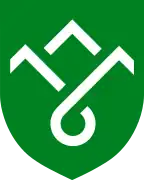Sollia (municipality)
Sollia is a former municipality in Hedmark county, Norway. The 511-square-kilometre (197 sq mi) municipality existed from 1864 until its dissolution in 1965. Since then, it has made up the northern part of the present-day Stor-Elvdal Municipality. The administrative centre of the municipality was the village of Sollia where Sollia Church is located.[1]
Sollia herred
Sollien herred (historic) Solliden herred (historic) | |
|---|---|
 Hedmark within Norway | |
 Sollia within Hedmark | |
| Coordinates: 61°46′51″N 10°24′00″E | |
| Country | Norway |
| County | Hedmark |
| District | Østerdalen |
| Established | 1 Jan 1864 |
| • Preceded by | Ringebu Municipality |
| Disestablished | 1 Jan 1965 |
| • Succeeded by | Stor-Elvdal Municipality |
| Administrative centre | Sollia |
| Area (upon dissolution) | |
| • Total | 511 km2 (197 sq mi) |
| Population (1965) | |
| • Total | 356 |
| • Density | 0.70/km2 (1.8/sq mi) |
| Time zone | UTC+01:00 (CET) |
| • Summer (DST) | UTC+02:00 (CEST) |
| ISO 3166 code | NO-0431 |
History
The parish of Solliden (population: 386) was established as a municipality on 1 January 1864 when it was separated from Ringebu Municipality. The new municipality was originally part of Kristians amt (county) when it was established. On 1 January 1891, the municipality of Solliden was transferred to the neighboring county: Hedemarkens amt. An uninhabited part of Ringebu was moved to Solliden on 1 January 1899. In the early 20th century, the name was spelled as Sollien. On 18 November 1921, the name of the municipality was officially changed from Sollien to Sollia. During the 1960s, there were many municipal mergers across Norway due to the work of the Schei Committee. On 1 January 1965, Sollia (population: 356) was merged into the neighboring municipality of Stor-Elvdal (population: 3,808).[1][2]
Name
The municipality (originally the parish) is named after the old Sollia farm (Old Norse: Sóllið) since the first Sollia Church was built there. The first element is identical with the word sól which means "sun". The last element comes from the word hlíð which means "hillside" or "slope". Thus, the name means "the sunny hillside".[3]
Government
During its existence, this municipality was governed by a municipal council of directly elected representatives. The mayor was indirectly elected by a vote of the municipal council.[4]
Municipal council
The municipal council (Herredsstyre) of Sollia was made up of representatives that were elected to four year terms. The party breakdown of the final municipal council was as follows:
| Party Name (in Norwegian) | Number of representatives | |
|---|---|---|
| Labour Party (Arbeiderpartiet) | 6 | |
| Joint List(s) of Non-Socialist Parties (Borgerlige Felleslister) | 7 | |
| Total number of members: | 13 | |
| Party Name (in Norwegian) | Number of representatives | |
|---|---|---|
| Labour Party (Arbeiderpartiet) | 7 | |
| Joint List(s) of Non-Socialist Parties (Borgerlige Felleslister) | 6 | |
| Total number of members: | 13 | |
| Party Name (in Norwegian) | Number of representatives | |
|---|---|---|
| Labour Party (Arbeiderpartiet) | 7 | |
| Joint List(s) of Non-Socialist Parties (Borgerlige Felleslister) | 6 | |
| Total number of members: | 13 | |
| Party Name (in Norwegian) | Number of representatives | |
|---|---|---|
| Labour Party (Arbeiderpartiet) | 6 | |
| Joint List(s) of Non-Socialist Parties (Borgerlige Felleslister) | 6 | |
| Total number of members: | 12 | |
| Party Name (in Norwegian) | Number of representatives | |
|---|---|---|
| Labour Party (Arbeiderpartiet) | 6 | |
| Joint List(s) of Non-Socialist Parties (Borgerlige Felleslister) | 6 | |
| Total number of members: | 12 | |
| Party Name (in Norwegian) | Number of representatives | |
|---|---|---|
| Labour Party (Arbeiderpartiet) | 6 | |
| Joint List(s) of Non-Socialist Parties (Borgerlige Felleslister) | 6 | |
| Total number of members: | 12 | |
| Party Name (in Norwegian) | Number of representatives | |
|---|---|---|
| Labour Party (Arbeiderpartiet) | 5 | |
| Conservative Party (Høyre) | 1 | |
| Farmers' Party (Bondepartiet) | 4 | |
| Liberal Party (Venstre) | 2 | |
| Total number of members: | 12 | |
| Note: Due to the German occupation of Norway during World War II, no elections were held for new municipal councils until after the war ended in 1945. | ||
References
- Thorsnæs, Geir, ed. (8 June 2020). "Sollia". Store norske leksikon (in Norwegian). Kunnskapsforlaget. Retrieved 30 January 2022.
- Jukvam, Dag (1999). Historisk oversikt over endringer i kommune- og fylkesinndelingen (PDF) (in Norwegian). Statistisk sentralbyrå. ISBN 9788253746845.
- Rygh, Oluf (1900). Norske gaardnavne: Hedmarkens amt (in Norwegian) (3 ed.). Kristiania, Norge: W. C. Fabritius & sønners bogtrikkeri. pp. 360–361.
- Hansen, Tore; Vabo, Signy Irene, eds. (20 September 2022). "kommunestyre". Store norske leksikon (in Norwegian). Kunnskapsforlaget. Retrieved 1 January 2023.
- "Kommunevalgene 1963" (PDF) (in Norwegian). Oslo: Statistisk sentralbyrå. 1964.
- "Kommunevalgene og Ordførervalgene 1959" (PDF) (in Norwegian). Oslo: Statistisk sentralbyrå. 1960.
- "Kommunevalgene og Ordførervalgene 1955" (PDF) (in Norwegian). Oslo: Statistisk sentralbyrå. 1957.
- "Kommunevalgene og Ordførervalgene 1951" (PDF) (in Norwegian). Oslo: Statistisk sentralbyrå. 1952.
- "Kommunevalgene og Ordførervalgene 1947" (PDF) (in Norwegian). Oslo: Statistisk sentralbyrå. 1948.
- "Kommunevalgene og Ordførervalgene 1945" (PDF) (in Norwegian). Oslo: Statistisk sentralbyrå. 1947.
- "Kommunevalgene og Ordførervalgene 1937" (PDF) (in Norwegian). Oslo: Statistisk sentralbyrå. 1938.

